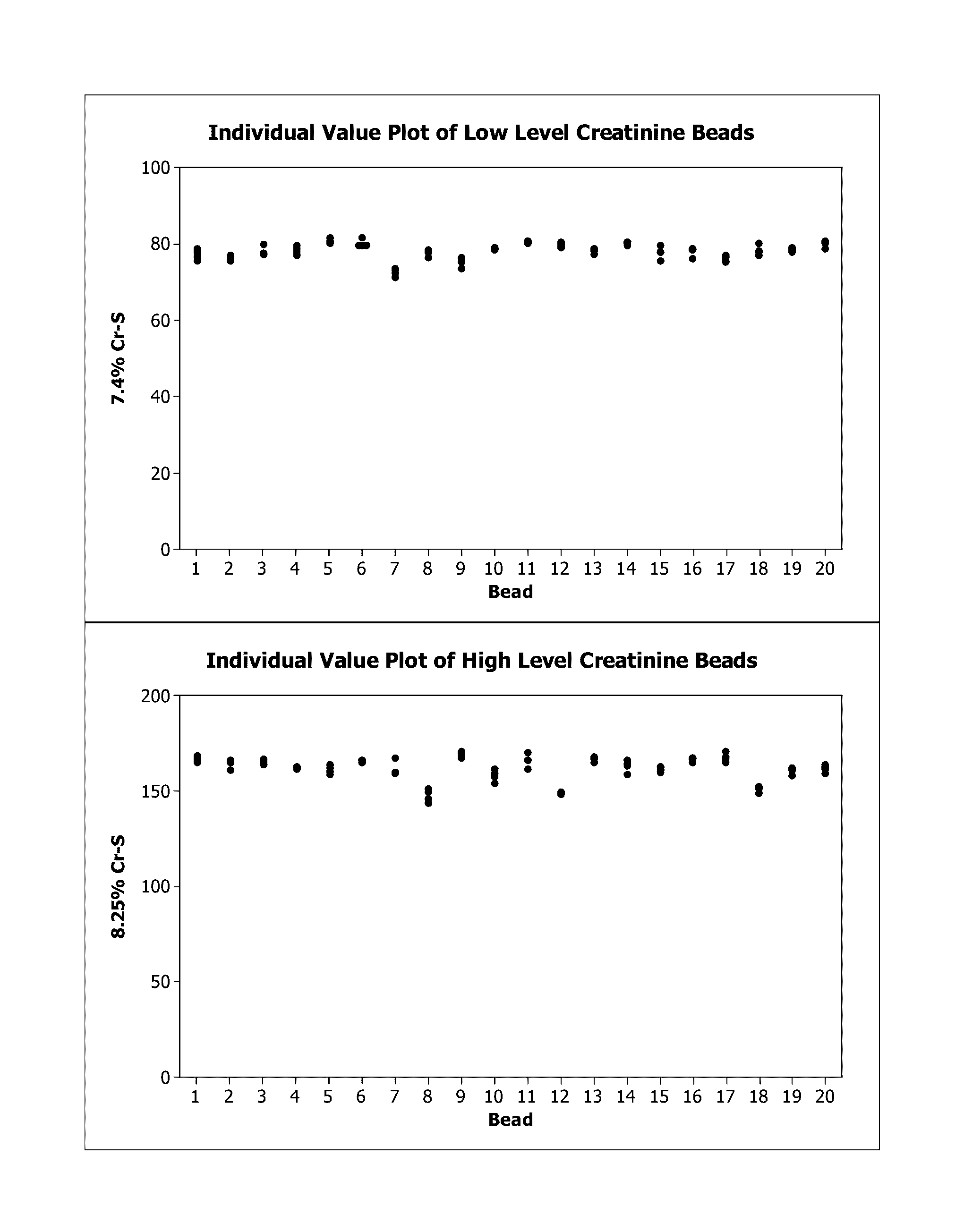Stabilization of labile analytes in reference materials
- Summary
- Abstract
- Description
- Claims
- Application Information
AI Technical Summary
Benefits of technology
Problems solved by technology
Method used
Image
Examples
example 1
1. Example 1
Preparation of Lyophilized Analyte Spheres
[0033]To manufacture a composition of lyophilized unstable analyte, small-diameter beads (3-9 mm), each containing a precise and accurate amount of a concentrated liquid (25-250 uL) containing one or multiple unstable analytes were dispensed and lyophilized as spheres. To help prepare consistent, stable, and durable spheres, excipients were used in the formulation of the spheres. The spheres can be produced commercially and in large scales by BioLyph, LLC (Hopkins, Minn.).
[0034]Two solutions containing 8390 mg / dL or 8665 mg / dL of creatinine in deionized water were used to prepare two different creatinine beads with different concentrations (low and high). These solutions were combined with additives, and then dispensed and lyophilized to produce the beads. The concentration of creatinine in the solution intended for production of the creatinine spheres was significantly higher than the concentration of creatinine control levels n...
example 2
2. Example 2
Preparation of Quality Control with Stable Analytes
[0037]Formulation of the Urine Chemistry Control begins by processing the normal human urine base. An enzymatic heat treatment is conducted to degrade endogenous labile creatinine. The urine is incubated with 100 U / dL Creatininase and 50 U / dL Creatinase at 25° C. for 1 hour. The next step is a 7-day, 41° C. incubation. Following treatment, the processed urine is diafiltered to remove the degradative enzymes. Finally, the collected urine is diluted with an equal volume of deionized water before testing creatinine background concentration.
[0038]
TABLE 2Endogenous creatinine concentration inurine base before and after processingCreatinine concentrationUnprocessed urine45.03 mg / dLCreatinine degraded urine12.55 mg / dL
[0039]Following the initial processing, stable analytes and other matrix constituents are added to the desired concentrations. The resulting control will have the analytes in a traditional Urine Chemistry Control e...
example 3
3. Example 3
Preparation of the Quality Control at the Point of Use
[0040]The quality control was prepared by rehydrating the appropriate number of analyte beads (each with a defined and assayed concentration) in the appropriate volume of the quality control with stable analytes to achieve the desired concentration for each level of control. Multiple levels of control with different concentration of analyte were prepared to achieve analyte concentrations at below, near, or above the clinical decision points of the assays. Analyte concentrations were then determined to ensure multi-level and clinical utility of the composition. The resulting compositions were then capped and stored at 2-8° C.
[0041]In this example, a tri-level multi-analyte Urine Chemistry Control was formulated. Tri-level creatinine utility was achieved by adding one low-level creatinine bead to 5 mL of Level 1 control, one high-level creatinine bead to 5 mL of Level 2 control, and one of each level creatinine bead (2 ...
PUM
 Login to View More
Login to View More Abstract
Description
Claims
Application Information
 Login to View More
Login to View More - R&D Engineer
- R&D Manager
- IP Professional
- Industry Leading Data Capabilities
- Powerful AI technology
- Patent DNA Extraction
Browse by: Latest US Patents, China's latest patents, Technical Efficacy Thesaurus, Application Domain, Technology Topic, Popular Technical Reports.
© 2024 PatSnap. All rights reserved.Legal|Privacy policy|Modern Slavery Act Transparency Statement|Sitemap|About US| Contact US: help@patsnap.com








